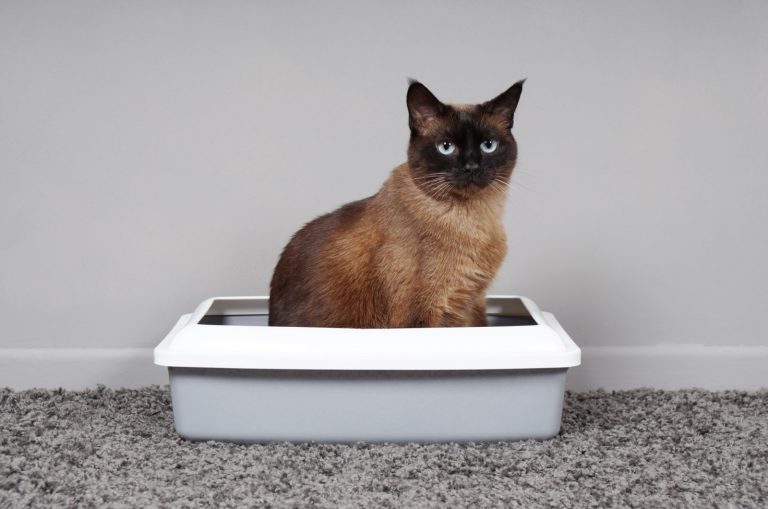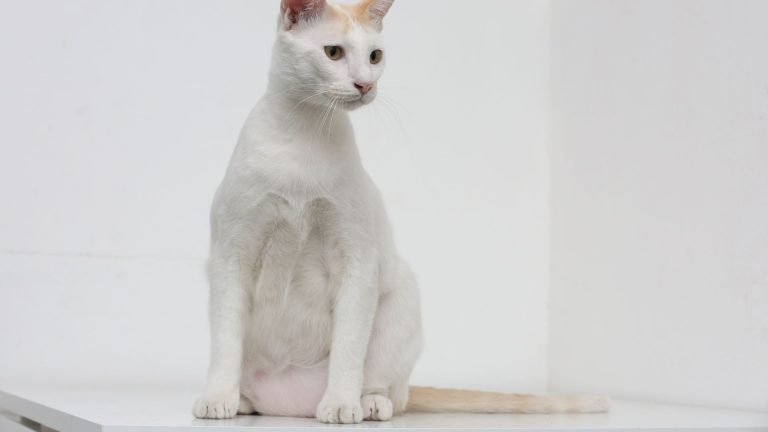Your Cat Ate A Rubber Band? Here’s 3 Things You Must Do

Cats are curious creatures. No one knows this better than cat owners. And how do we know that? Well, we always have to keep an eye on what they put in their mouths.
Although our cats’ curiosity is an adorable characteristic, it can sometimes be a dangerous one. A perfect example of this is when a cat eats a rubber band.
In this article, we will discuss the steps you should take when you notice your cat has eaten a rubber band, five effective ways to stop your cat from eating rubber bands and other small household items, and much more, so read on!
My Cat Ate A Rubber Band, What Now?
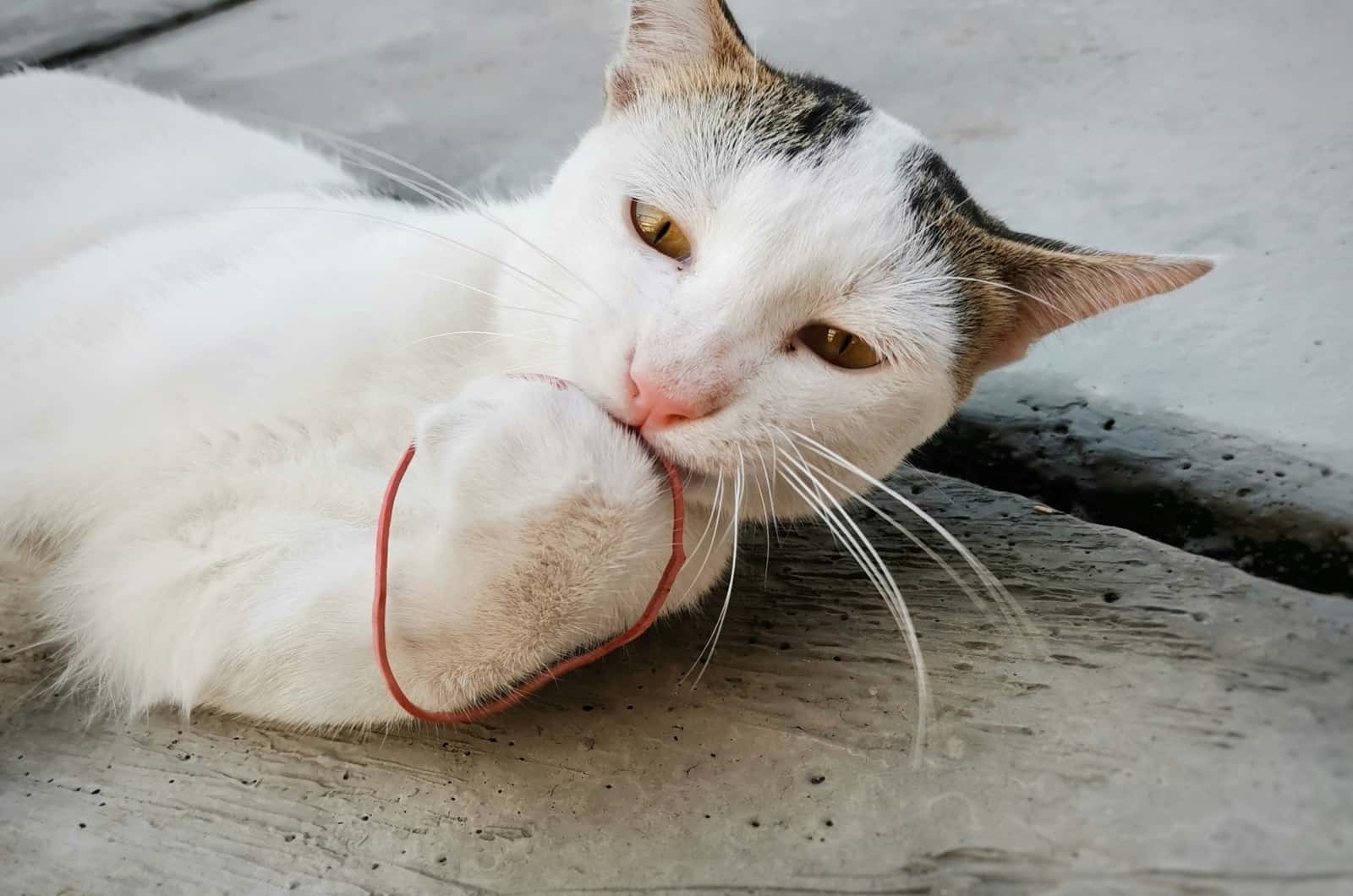
Cats often eat things they shouldn’t. They do this because of their natural curiosity and instinct to explore their environment. Sometimes, it may even be because they’re bored.
Nevertheless, it happened, so what now?
Please, know that there is no need to panic right away! Rubber band ingestion can be dangerous, but it’s not a reason to grab your cat right away and rush to the nearest vet.
Below, I’ve explained the 3 things to do (or 3 steps you should take) when you notice your cat has got a hold of a rubber band.
3 Things You Must Do When Your Cat Has Eaten A Rubber Band
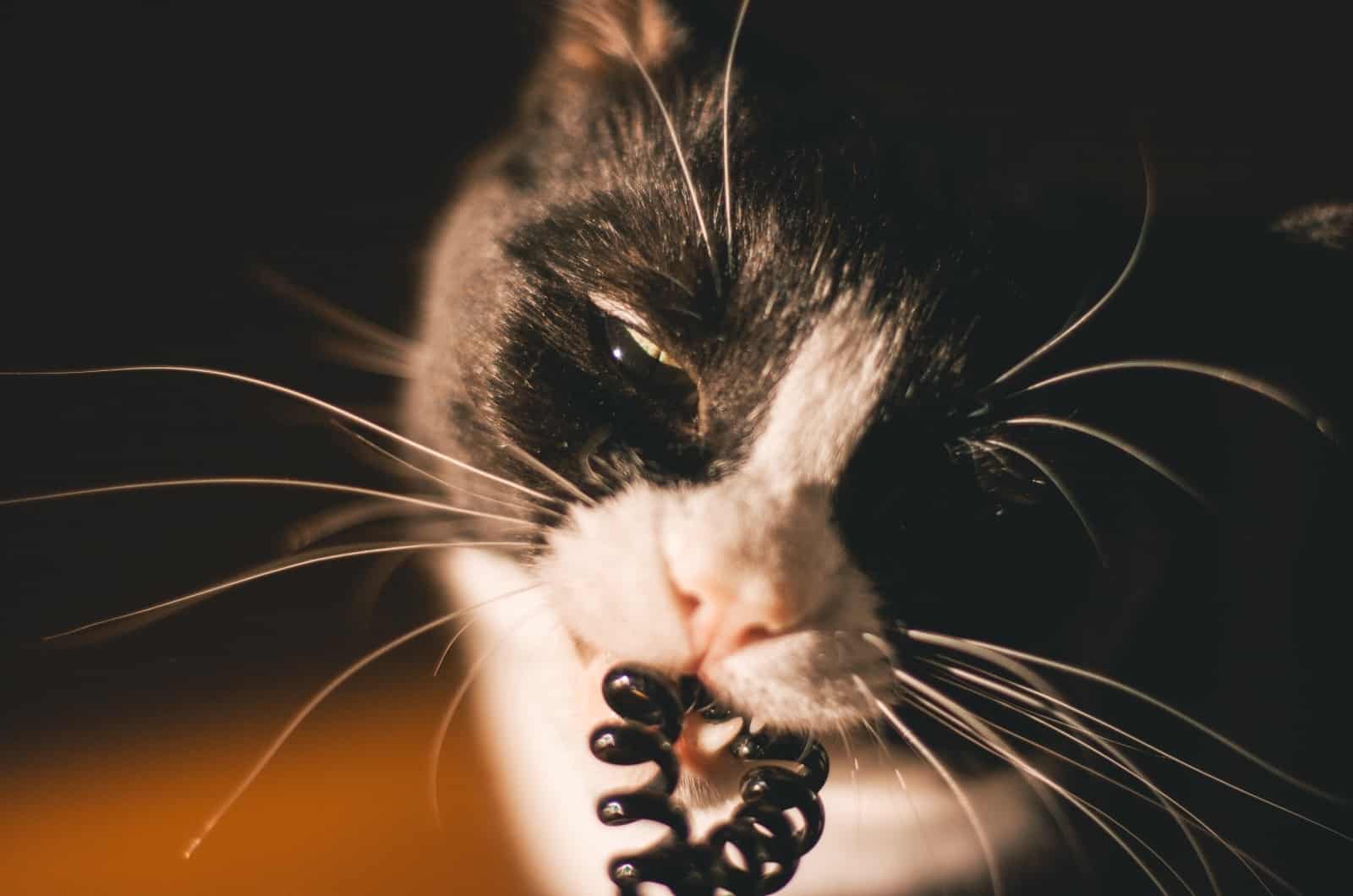
1. Remain Calm And Check Your Cat’s Mouth
If you suspect your cat has put a rubber band in its mouth, the first thing you need to do is check if the rubber band is still in the cat’s mouth. It’s possible it still is.
Gently open your cat’s mouth and look inside.
Be careful not to get bitten or scratched in the process. Your cat will definitely not like you forcefully opening its mouth, but it’s something you must do.
Look inside the cat’s mouth and try to locate the rubber band. Look for the rubber band on the tongue or in the back of the throat.
If the rubber band is visible, use tweezers or your fingers to gently remove it. Try to grip the object as close to the cat’s mouth as possible to avoid pushing it further down the throat.
Using tweezers can be dangerous, especially if the cat is nervous and restless, but it can be done, and it is worth it if you can remove the rubber band before the cat swallows it.
2. If Your Cat Already Swallowed A Rubber Band, Keep Track Of Your Cat’s Symptoms
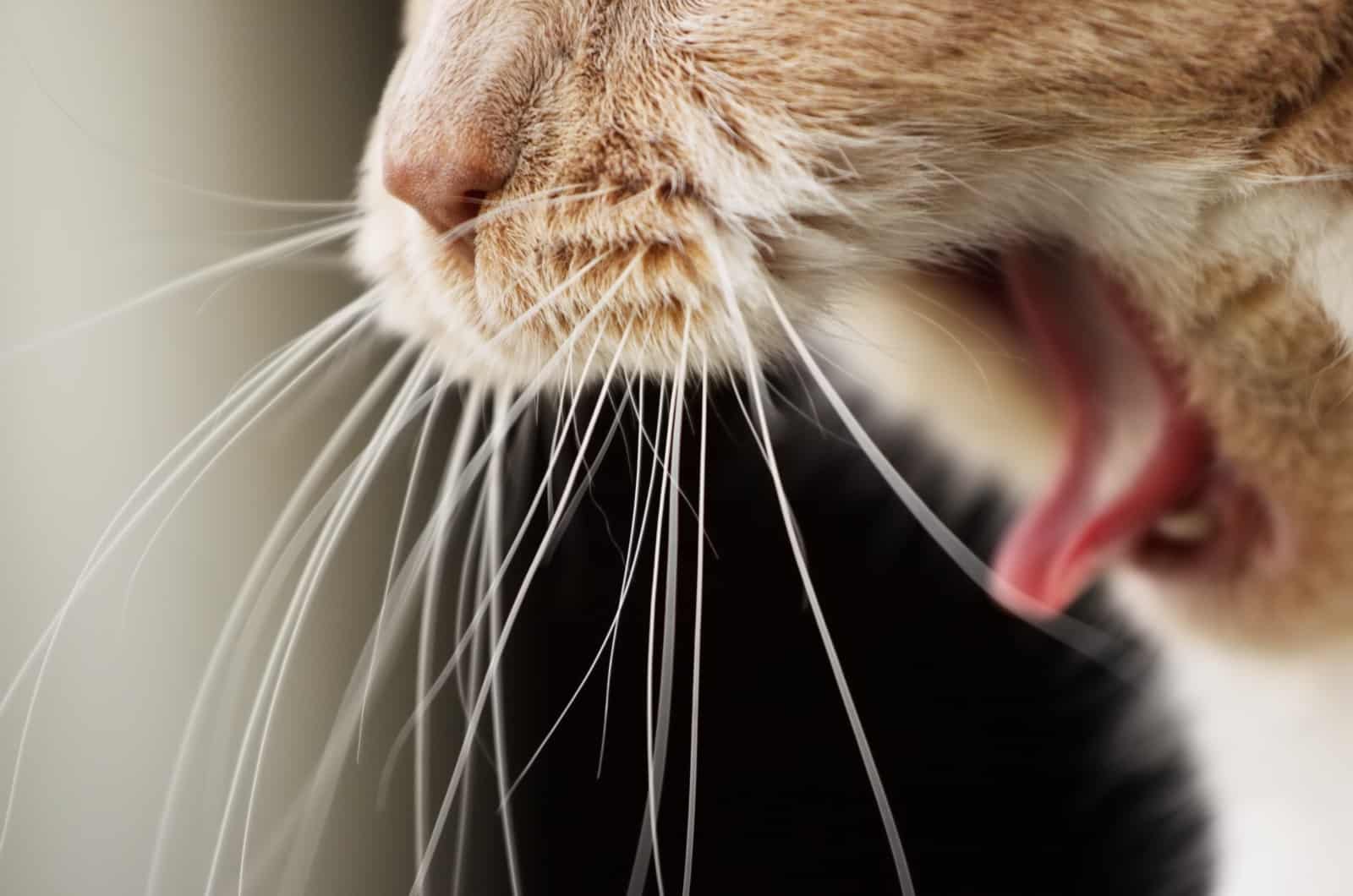
If you’re certain your cat has swallowed the rubber band, there is no need to panic right away. It’s possible nothing bad will happen and your cat will simply pass the rubber band (aka poop it out).
Let’s say you’ve just realized your cat ate a rubber band. Should you go to the vet right away? I would say no. But I definitely do advise you to keep a close eye on your cat that day, and the following days as well.
If you notice any symptoms of ill-health (as I’ll describe below), you will need to take your cat to the vet.
If you notice your cat has pooped out the rubber band, then there’s no need to worry; your kitty will be just fine!
However, it is possible for the rubber band to stay within the cat’s gastrointestinal system and get stuck there. That can lead to a number of health issues for the cat.
3. Go To The Vet If Your Cat Starts Vomiting Or Being Constipated
If your cat has ingested a rubber band and it has not been passed through their stool, it most likely means that the rubber band is still in the cat’s stomach or intestines.
Depending on the size and location of the rubber band, it may be stuck or tangled in the gastrointestinal tract, causing blockages.
An intestinal blockage, also called a bowel obstruction, is a condition in which the normal movement of the contents of the intestines is blocked.
Symptoms of intestinal blockage are:
• vomiting
• diarrhea
• loss of appetite
• abdominal pain
• straining to defecate
• lethargy
• behavior changes
If left untreated, an intestinal blockage can be life-threatening. Therefore, it’s extremely important to take your cat to the vet if you notice any of the symptoms mentioned above.
The Risks Involved In Rubber Band Ingestion
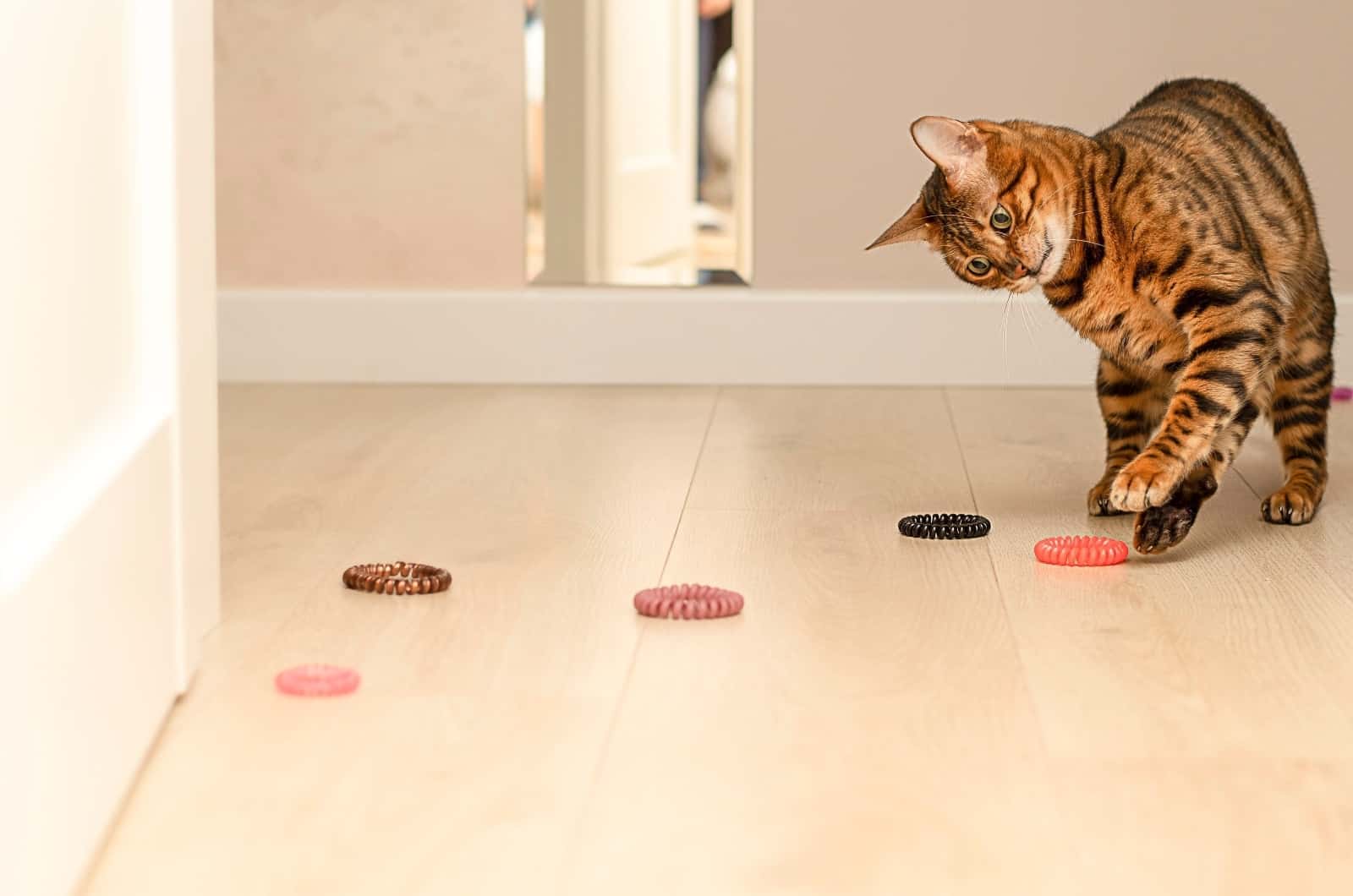
The first risk of a cat getting its paws on a rubber band is that the rubber band can become lodged in the throat, causing choking and difficulty breathing.
This can get dangerous very quickly, so this is the number one risk, especially if a cat gets more than one rubber band in its mouth.
If we suppose the cat has swallowed the rubber band(s), there is risk number two, which is intestinal obstruction.
What Happens To The Rubber Band After It’s Swallowed?
A rubber band cannot be broken down by the cat’s digestive system, as it’s made of a synthetic rubber substance.
In the stomach, the rubber band will be exposed to stomach acid, which will not degrade it but could cause some erosion or soften it. The softening could facilitate its passing through the intestinal tract.
However, this is not always the case and the rubber band could remain intact and cause an obstruction.
Therefore, the rubber band (or bands) will either be passed by the cat, or it will stay in the cat’s digestive system, and could potentially cause issues.
What Happens To The Cat After It Swallows A Rubber Band?
Smaller rubber bands may pass through the intestinal tract without causing an obstruction, while larger bands or multiple bands may become lodged and cause a complete obstruction.
A study about intestinal obstruction caused by foreign bodies in dogs and cats notes that if a cat is experiencing complete blockage, vomiting occurs within 24 to 72 hours after the obstruction, while cats with incomplete obstruction may experience vomiting 2 to 3 days after obstruction.
Because of this, you’ll need to be on the look-out: is your cat vomiting or not? Another important symptom of intestinal blockage is loss of appetite, constipation and changes in behavior due to discomfort.
For cats, intestinal obstruction can be a potentially fatal condition. It may result in a buildup of gas and liquids in the digestive system, which can cause discomfort.
Additionally, it can obstruct the movement of food and fluids through the digestive system, resulting in unpleasant side-effects, such as constipation and vomiting.
It’s important to seek veterinary care as soon as possible if you suspect your cat may have an intestinal obstruction as it can be life-threatening if not treated promptly!
I Brought My Cat To The Vet’s, What Can I Expect?
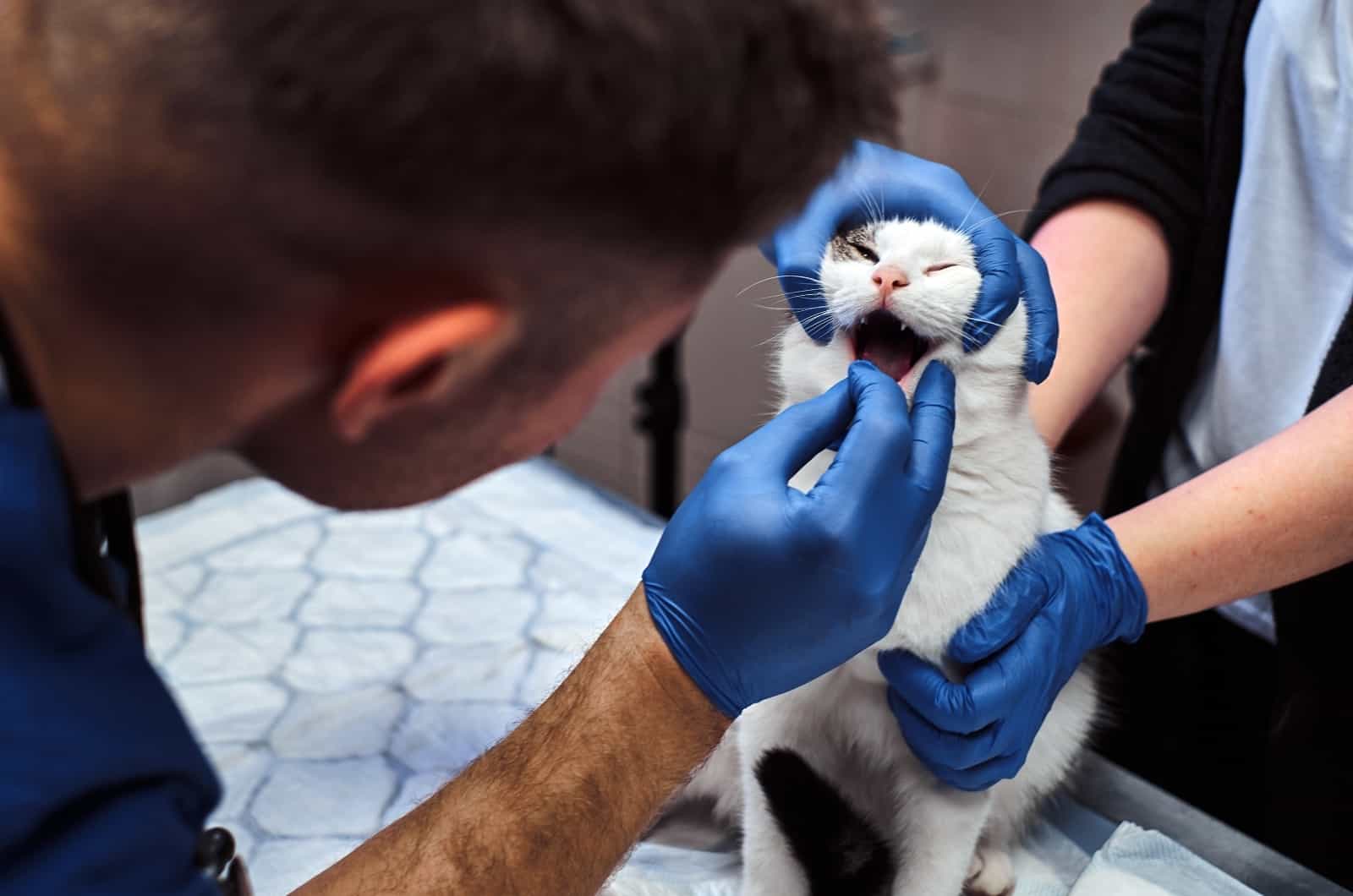
When you bring your cat to the vet, the vet will likely perform a thorough physical examination first, to assess your cat’s overall health.
The next step for the vet is to determine whether the cat has a gastrointestinal obstruction or not.
The vet may also carry out radiographs (x-rays) or an ultrasound to determine if the rubber band is lodged in the cat’s intestinal tract, and if so, where it is located.
Depending on the results, there are two potential options:
• If the obstruction is not severe, the veterinarian may advise keeping an eye on the cat for a while to see whether the rubber band goes through the digestive tract on its own.
• If the obstruction is severe, the vet will opt for surgical removal of the foreign body.
VCA Animal Hospital states: “Although most foreign bodies do pass uneventfully through the intestinal tract, if an obstruction occurs for some reason, surgical removal of the blocked object is the only treatment.“
Surgical Removal Of Rubber Band(s)
When an object, such as a rubber band, is stuck in the intestines, surgery is often the best solution to remove it. It is costly and invasive, but when the blockage is taken care of promptly, the chances of complete recovery are extremely high.
Either laparoscopic surgery or open surgery can be used to do the operation.
Laparoscopy
In laparoscopic surgery, the veterinarian will use a small camera and special instruments to access the intestines. The rubber band(s) will then be removed.
The benefits of laparoscopy include less pain and discomfort, and shorter recovery time compared to open surgery.
Open Surgery
In some cases, laparoscopy is not possible, and open surgery is the only option to remove whatever’s causing the blockage.
In order to reach the intestines and remove the rubber band, the veterinary surgeon needs to make an incision in the cat’s belly. After the incision has been made, the surgeon will remove the foreign body.
Take a look at this interesting video of two veterinarians deciding what to do with their patient that ate rubber bands:
Potential Costs Associated With Treatment
As most cat owners would like to know what they can expect to pay for their furry friend’s treatment, I’ve decided to include this section in the article as well.
The cost associated with the treatment of a cat that has swallowed a rubber band can vary depending on the specific circumstances; most importantly whether the cat is suffering from an intestinal blockage or not.
However, intestinal blockage or not, the treatment can be quite expensive due to the number of tests the vet might require to get to the bottom of your cat’s issue.
If No Surgery Is Involved
There are a few points cat owners need to consider:
• The price of the examination is usually around $50 to $150, with some clinics charging more if the examination is an emergency.
• Radiographs (x-rays) or ultrasound may be used to see what’s going on in the cat’s digestive tract, and the price of x-ray procedure ranges from $100 to $400, while ultrasound tends to be $300-$500.
If Surgery Is Involved
Apart from the costs I’ve already mentioned, some cats might need to have surgery, as it may be the only option to remove an obstruction efficiently.
Note that this option is more likely if your cat has ingested more than one rubber band, or the rubber band your cat ingested is a large one.
The cost of surgery is in the range of several thousand dollars. The exact price depends on the extent of the procedure and whether it is an emergency surgery or not.
Additionally, cats that require surgery or critical care may need to stay in the hospital for a few days, which can increase the overall cost of treatment.
The cost of this surgery and after-care can be high, but if you have pet insurance, some or all of the expenses may be taken care of. That’s why I always advise pet owners to invest in pet insurance, as you never know if one day you’ll need it.
5 Ways To Stop Your Cat From Eating Rubber Bands (And Similar Items)

One common problem that cat owners face is their cats ingesting foreign objects, such as rubber bands, discussed above.
Ingesting foreign objects can be dangerous and even life-threatening for your cat, as they can cause intestinal blockages.
Therefore, the key to preventing your cat getting an intestinal blockage is to prevent the cat from eating foreign objects.
How do you do that? I’ve listed 5 steps you should take!
1. Keep The Small “Hazzard Items” Out Of Your Cat’s Reach
Keeping rubber bands and other small, hazardous items out of your cat’s reach is the first step in preventing them from eating them.
This seems to be the most obvious way to stop cats from eating things they shouldn’t eat.
This includes keeping rubber bands in drawers or containers that your cat cannot access. Another important thing is being mindful of where you leave rubber bands and similar items around your home.
2. Use Some Type Of A Deterrent
Using a bitter spray or other deterrents on rubber bands and other hazardous items can discourage your cat from chewing on them.
These sprays are available at pet stores or can be made at home with a mixture of water and lemon juice.
The purpose of a cat deterrent is to signal to the cat “hey, stay away from me”. These types of sprays are specially made to contain scents cats absolutely hate.
Hopefully, your cat will associate the unpleasant scent with the rubber bands and similar items, and will stay away from them in the future!
3. Buy Chew Toy As Rubber-Band Alternatives
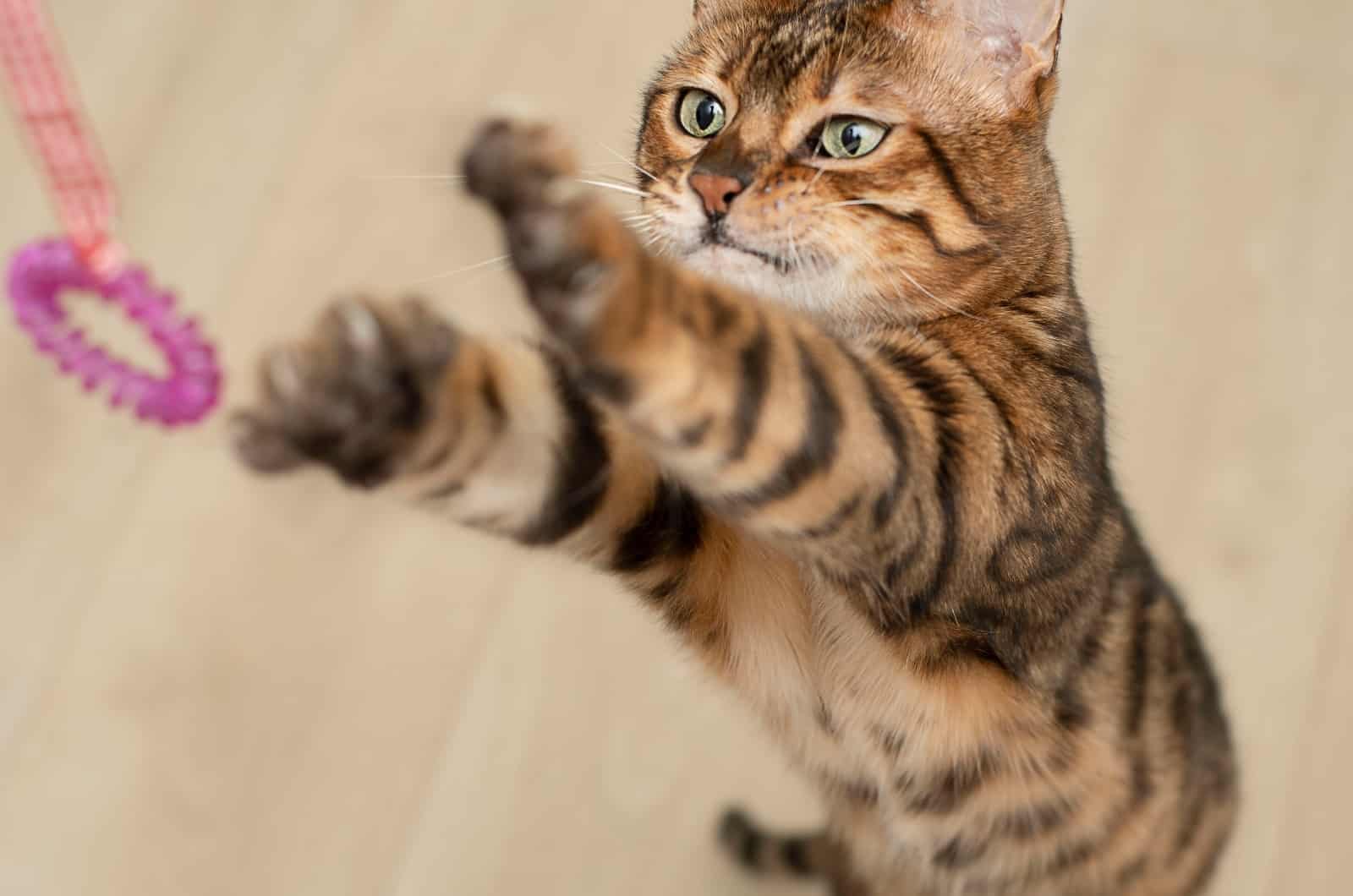
It is possible for a cat to eat a rubber band on more than one occasion. If your cat has been involved in more “rubber band accidents”, then it could be that your cat likes chewing on them.
If this is the case, then you should try buying your cat a chewing toy. Truth be told, dogs are more fond of chewing toys than cats are, but still, there are many chew toy options for cats as well. I’m sure you’ll be able to find one in no time.
Providing your cat with appropriate chew toys can help to redirect their chewing behavior away from rubber bands and other hazardous items, which is your goal.
4. Keep Your Cat Entertained
Cats who are bored or anxious may be more likely to chew on rubber bands or other hazardous items. In a way, that’s how they entertain themselves.
However, this type of entertainment can get very dangerous very quickly, so it’s best your cat finds another type of entertainment. This is where you step in.
You can provide your cat with entertainment in the following ways:
• Devote some time of your day for an owner-cat playdate.
Set aside specific times during the day for playtime with your cat. This could be just 10 minutes in the morning and evening. Simple games like chasing a ball of yarn or a toy mouse can be very entertaining for your cat and you as well!
• Provide your cat with window access and buy a bird feeder.
Cats absolutely love watching birds outside the window, and you’ll often see them chirping while looking outside. Some cats might enjoy this form of entertainment for hours!
• Get your cat a cat tree and a scratching post.
Look online and in pet stores for different types of cat trees and scratching posts. Place the cat tree or scratching post in an accessible location for your cat, such as a main living area. I have no doubt your cat will absolutely love it.
• Toys, toys, and more toys.
Toys can alleviate boredom in cats by providing both mental and physical stimulation. They can also help to satisfy a cat’s natural hunting instincts and keep them active, and most importantly, away from rubber bands.
• Get another cat?!
If you decide to get another cat, there are benefits such as providing companionship and entertainment for your current cat and helping to alleviate loneliness. It might not be such a crazy idea, huh?
5. Consult With A Veterinarian
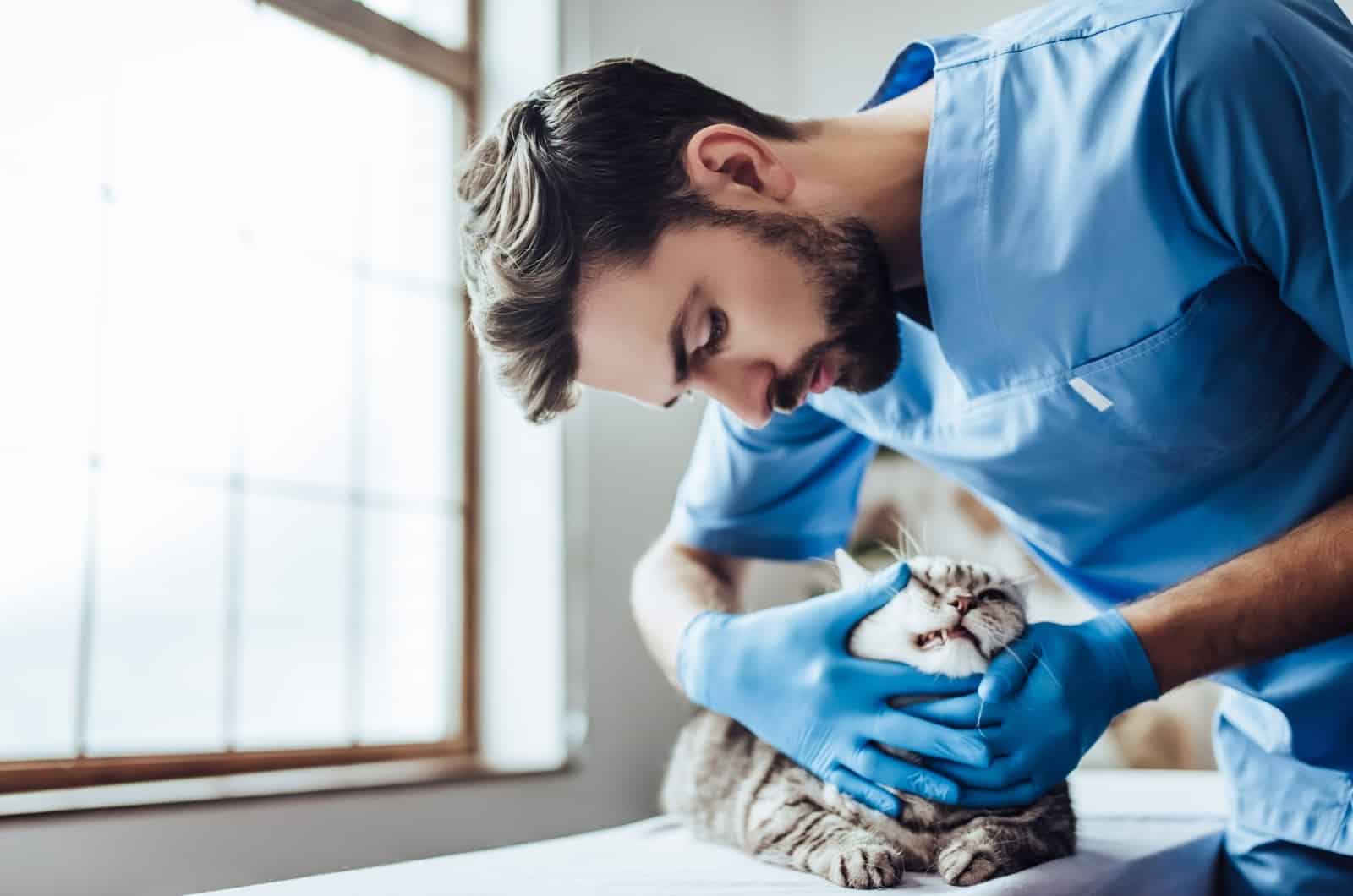
If your cat continues to chew on rubber bands or similar items, it’s important to consult with a veterinarian.
They can rule out any underlying medical conditions and provide guidance on how to address this behavior.
A potential reason your cat keeps eating rubber bands and other similar items is due to a medical condition known as Pica disorder.
Pica disorder is a condition in which a cat compulsively ingests non-food items, such as rubber bands, plastic, or fabric.
Cats that eat non-food items are at an extremely high risk of developing an intestinal blockage, which is a life-threatening condition.
Therefore, if you suspect your cat has Pica, please, talk about your concerns with a veterinarian.
A Couple Of Other Items You Need To Be Cautious Of

Cats are naturally curious creatures and they’re very likely to find anything you accidently drop on the floor or leave unattended.
I always tell cat owners, especially if they’re new to owning a cat, to keep an eye on the following items their kitties can ingest:
• Hair ties
• Loose clothing strings or yarn
• Paper clips
• Pins
• Needles
• Any type of ribbon
• Plastic bags
• Buttons
• Beads
• Very small toys
Whatever your cat has eaten, it’s important to be on the look-out for the following symptoms of ill health:
• vomiting and diarrhea
• abdominal pain
• loss of appetite and refusal to eat
• loss of energy and behavior changes
• changes in litter box habits (such as straining while pooping)
Of course, it can happen that your cat throws up the foreign body or simply poops it out. This is good and it’s lucky for your cat (and you) if this happens.
If it does not, please pay attention to your cat’s behavior and if it’s showing any of the symptoms of ill health that I’ve mentioned above.
In Conclusion
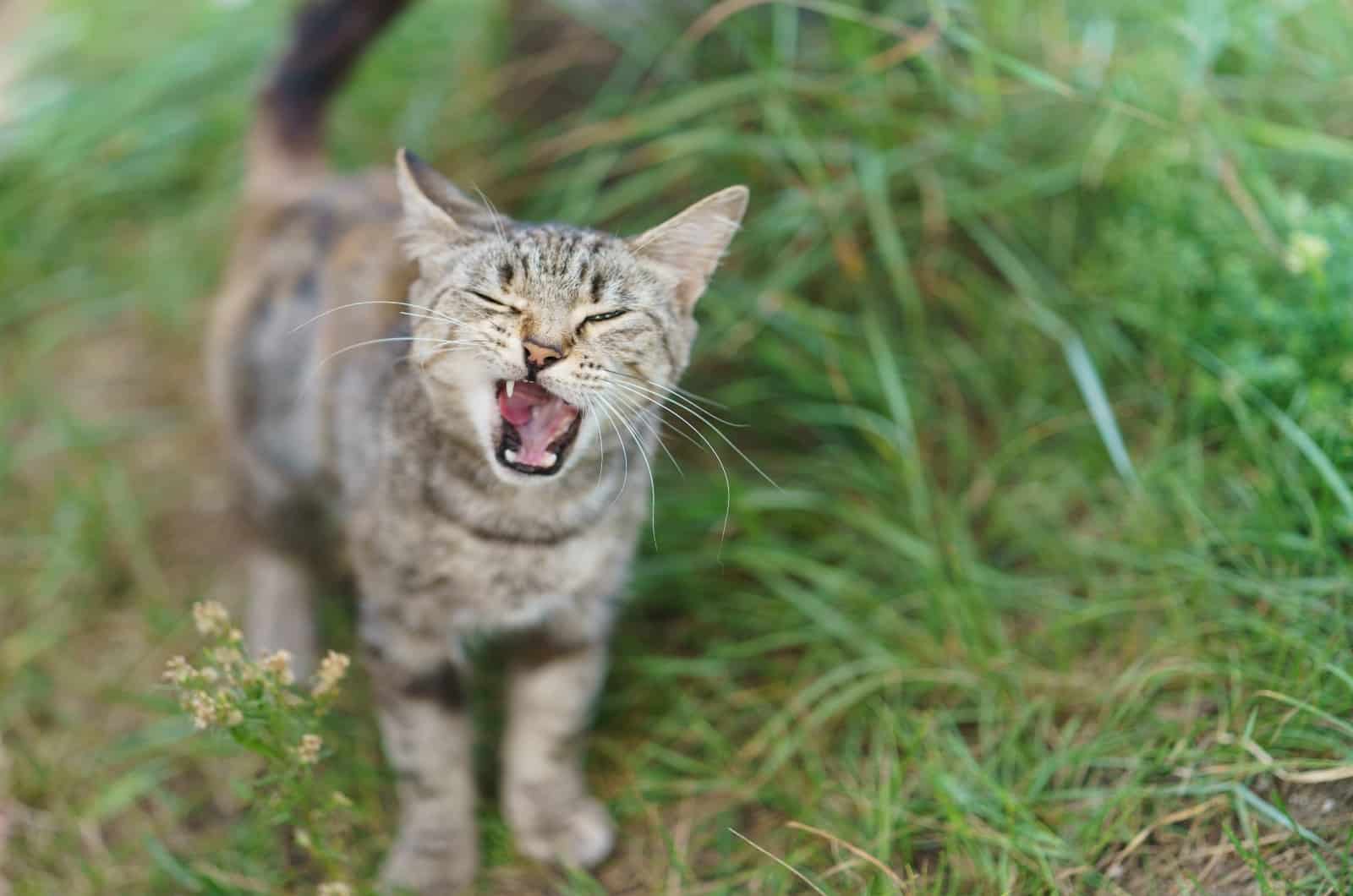
After reading this article, I’m sure you understand how serious and potentially life-threatening it can be for a cat to eat a rubber band, let alone more than one.
It is crucial to take immediate action if you suspect your cat has consumed a rubber band:
• Try to safely remove the rubber band if it is visible in the mouth or throat.
• If you cannot get the rubber band out, or your cat has already swallowed it, please take your cat to the vet.
To prevent such incidents from happening in the future, it is important to keep small and potentially harmful items out of reach of your cat.
Remember the old saying “curiosity killed the cat”, as it is important to keep your cat safe and secure in their surroundings!
By following the simple steps I’ve shown you in this article, you can help ensure the safety and well-being of your feline friend.
Goodbye for now, and stay safe!


